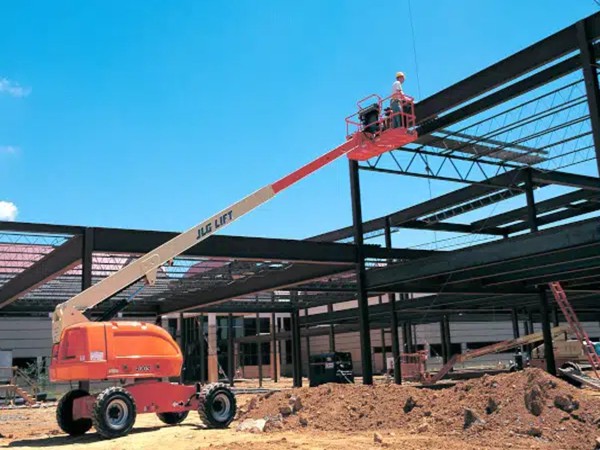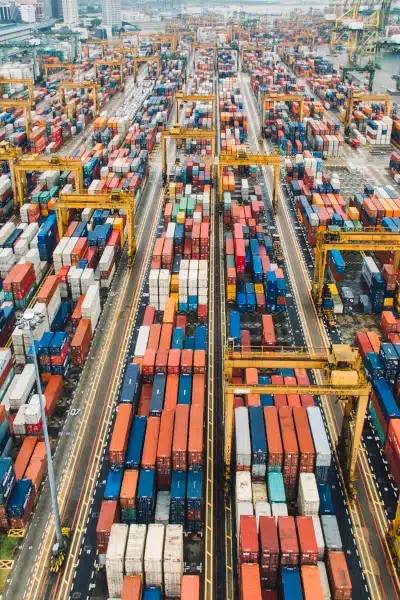Complete Aerial Lift Guide For Buying And Rental In 2021
April 20, 2021
Aerial work platforms (also known as man lifts) are critical to reach certain areas on job sites. Their usage has grown dramatically over the decades. Learn more about lifts, and how to rent or buy a lift.

Construction job sites often require crew members to access hard-to-reach areas at elevated heights, both indoors and outdoors. Over the years aerial lifts (often referred to as "lifts", "man lifts", "manlifts", "JLG" or "Genie") have become the favorite cost-effective choice for getting the job done.
Aerial lifts were not common on most sites several decades ago. Safety regulations, technology improvements and more advanced machinery solutions have led to the strong adoption of aerial lifts. The outlook for the aerial lift industry is very positive — Grand View Research estimates that the industry will grow 6% per year between 2020 and 2027, to reach $17 billion in sales.
Aerial lifts can be grouped into the following categories:
- Boom lifts elevate a worker in a bucket or compact work platform. A grounded base and hydraulic lift system extend the lift. Boom lifts are capable of reaching out horizontally and vertically from the base. Boom lifts can be used indoors and outdoors.
- Scissor lifts have a large flat aerial work platform elevated by interlocking crisscrossed braces. Scissor lifts extend vertically by squeezing together the braces, similar to the way a pair of household scissors work. Scissor lifts are suitable for both indoor and outdoor work.
- Vertical lifts extend vertically and are smaller than scissor lifts. The platform typically is big enough for only one person, and the vertical height lower is than scissor lifts. Vertical lifts tend to be lighter, more compact and less expensive than scissor lifts. Vertical lifts are meant to be used primarily indoors.
Powered lifts typically use diesel or electric batteries as a power source. Electric power is better suited for indoor applications to prevent a buildup of harmful fumes indoors. Some lifts offer a hybrid option to run on both diesel and electric.
What Is A Boom Lift?
Boom lifts elevate a worker (or workers) in a small bucket or work platform in the air. There are several types of boom lifts, all of which have different reach capabilities and specifications. Most boom lifts have a wheeled base that is capable of moving over a wide range of ground conditions.
Some boom lifts have a track base that is capable of handling rough terrain. Other boom lifts use stationary legs and outriggers (this type of lift is often referred to as a "spider lift" or "atrium lift").
Boom lifts can be divided into two primary categories based on the way the arm operates:
Telescopic boom lift

Have straight arms and offer a long reach. The arm is always straight, and the base is able to rotate. The arm movement is similar to a telescope, where it extends and retracts in one direction. Telescopic boom lifts are a good choice if you need a far or high reach and your space has plenty of room to access the point.
Some larger telescopic boom lifts have a jib extension near the platform, which provides the boom lift with some articulating movement.
Articulating boom lift

Also known as a "knuckle boom lift" and "cherry picker", the articulating boom lift arm has several joints and is capable of more flexibility when compared to a telescopic boom lift. Articulating boom lifts tend to be better suited for accessing hard-to-reach areas because they have more ways to maneuver and access the area (telescopic boom lifts can only extend into the area while articulating boom lifts can approach the area from many different angles).
The arm acts sort of like a finger (has multiple joints). An articulating boom lift's reach tends to be shorter than a comparable telescopic boom lift (all else equal). Some articulating boom lifts have a jib extension that can provide an extra 6 feet of extension in any direction.
Boom lift tires can vary depending on the application and intended terrain. Wide flotation tires are best for sandy and soggy conditions. Solid rubber tires are puncture-resistant (a perk on job sites). Some tires are non-marking, which is important for finished floors and sports arenas.
What Is A Scissor Lift?

Scissor lifts often feature a wide platform that extends vertically. The extension mechanism features a series of cross-brace supports that function similar to a scissor to extend and retract the platform. Scissor lifts are very popular for indoor applications.
Scissor lifts are very stable and can handle heavy loads. Some lifts can handle up to six average-size adults.
Rough terrain scissor lifts operate similar to basic scissor lifts, but they typically have more rugged tires and support extensions to stabilize the base. Rough terrain scissor lifts can be used with a greater variety of outdoor terrains.
What Is A Vertical Lift?

Vertical lifts, also referred to as "push arounds", are smaller lifts that extend vertically and often are designed for only one person. The platforms tend to be narrower than scissor lifts, as well as lighter and less expensive.
Some vertical lifts are able to drive, enabling the operator to move through a warehouse or pathway. Vertical lifts are typically used for lighter industrial applications. The vertical reach of vertical lifts tends to be lower than scissor lifts.
Who Are The Major Aerial Lift Manufacturers?
JLG (brand owned by Oshkosh Corporation) and Genie (branded owned by Terex Corporation) are the two largest brands in the access space right now. People at job sites often refer to aerial lifts as the "JLG" or "Genie", similar to how people refer to tissues as "Kleenex" — the brands have become synonymous with lifts. Haulotte, Snorkel and Skyjack are major players in the space.
How To Choose The Right Lift For Your Job
You should consider the following items when deciding the proper lift for your job:
- What height do I require? Scissor lifts are suited for heights 40 feet and below. Anything higher typically requires a boom lift.
- How many people need to be on the platform at once? Some boom lift platforms can accommodate up to six average size people (varies by weight specifications). Vertical lifts often have space for only one person. Scissor lifts can be more limited relative to boom lifts, depending on the bucket or platform. Just like flying on an airplane, total weight calculation is very important — make sure you check that your total weight will be below the manufacturer's recommended maximum weight load.
- What is my budget? Generally speaking the larger and more complex the machine, the more expensive it will be to rent or buy. The large 150+ ft boom lifts cost much more than a simple 30 ft scissor lift.
- What is the terrain? Scissor lifts and vertical lifts are better suited for flat and level ground. Boom lifts provide more flexibility.
- How easy is it to access the space? If you have plenty of space to access the desired point, then you can use any solution. Vertical and scissor lifts must have the immediate opening below the space open. If there is a vertical blockage covering the point you need to access, then a boom lift is likely a better option.
- Do I require mobility? Most boom lifts are able to move on their own and are capable of driving over bumpy terrain while extended. Many scissor lifts are able to move on their own, but they tend to be more limited.
Should I Rent or Buy My Lift?
The decision to rent or buy is a personal decision that will depend on your preferences, financing, and ability to store and maintain the equipment. Some people prefer the hassle-free option of renting, while others prefer the benefits of long-term ownership.
Lift rentals are very popular because it offers flexibility, a variety of equipment and zero maintenance obligation. Major rental companies including United Rentals, Herc Rentals and Sunbelt often allocate between a quarter and half of their annual machinery spend just to aerials.
Rentals rates are typically based on a daily, weekly or monthly term. Longer-term rentals tend to be cheaper on a per-day basis. It's important to note that you will often incur transportation costs to and from the rental company.
If you plan on using your lift often, have the space to store it and the means to service it, then buying might be a better option for you.
Note:
All images are from JLG.com



